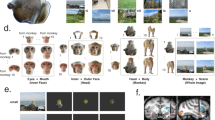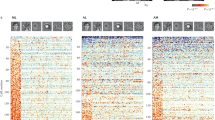Abstract
Being able to recognize the faces of our friends and family members no matter where we see them represents a substantial challenge for the visual system because the retinal image of a face can be degraded by both changes in the person (age, expression, pose, hairstyle, etc.) and changes in the viewing conditions (direction and degree of illumination). Yet most of us are able to recognize familiar people effortlessly. A popular theory for how face recognition is achieved has argued that the brain stabilizes facial appearance by building average representations that enhance diagnostic features that reliably vary between people while diluting features that vary between instances of the same person. This explains why people find it easier to recognize average images of people, created by averaging multiple images of the same person together, than single instances (i.e. photographs). Although this theory is gathering momentum in the psychological and computer sciences, there is no evidence of whether this mechanism represents a unique specialization for individual recognition in humans. Here we tested two species, chimpanzees (Pan troglodytes) and rhesus monkeys (Macaca mulatta), to determine whether average images of different familiar individuals were easier to discriminate than photographs of familiar individuals. Using a two-alternative forced-choice, match-to-sample procedure, we report a behaviour response profile that suggests chimpanzees encode the faces of conspecifics differently than rhesus monkeys and in a manner similar to humans.



Similar content being viewed by others
References
Andrews S, Jenkins R, Cursiter H, Burton AM (2015) Telling faces together: learning new faces through exposure to multiple instances. Q J Exp Psychol 68(10):2041–2050. doi:10.1080/17470218.2014.1003949
Andrews S, Burton AM, Schweinberger SR, Wiese H (2016) Event-related potentials reveal the development of stable face representations from natural variability. Q J Exp Psychol. doi:10.1080/17470218.2016.1195851
Balas BJ, Nelson CA, Westerlund A, Vogel-Farley V, Riggins T, Kuefner D (2010) Personal familiarity influences the processing of upright and inverted faces in infants. Front Hum Neurosci 4:1. doi:10.3389/neuro.09.001.2010
Bell AH, Malecek NJ, Morin EL, Hadj-Bouziane F, Tootell RB, Ungerleider LG (2011) Relationship between functional magnetic resonance imaging-identified regions and neuronal category selectivity. J Neurosci 31(34):12229–12240. doi:10.1523/jneurosci.5865-10.2011
Bruce V (1994) Stability from variation: the case of face recognition the M.D. Vernon memorial lecture. Q J Exp Psychol Sect A 47(1):5–28. doi:10.1080/14640749408401141
Bruce V, Young A (1986) Understanding face recognition. Br J Psychol 77(Pt 3):305–327
Bruce V, Burton AM, Dench N (1994) What’s distinctive about a distinctive face? Q J Exp Psychol A 47(1):119–141
Bruce V, Henderson Z, Greenwood K, Hancock PJB, Burton AM, Miller P (1999) Verification of face identities from images captured on video. J Exp Psychol Appl 5(4):339–360. doi:10.1037/1076-898X.5.4.339
Burton AM, Jenkins R, Hancock PJ, White D (2005) Robust representations for face recognition: the power of averages. Cogn Psychol 51(3):256–284. doi:10.1016/j.cogpsych.2005.06.003
Burton AM, Jenkins R, Schweinberger SR (2011) Mental representations of familiar faces. Br J Psychol 102(4):943–958. doi:10.1111/j.2044-8295.2011.02039.x
Burton AM, Kramer RS, Ritchie KL, Jenkins R (2016) Identity from variation: representations of faces derived from multiple instances. Cogn Sci 40(1):202–223. doi:10.1111/cogs.12231
Caharel S, d’Arripe O, Ramon M, Jacques C, Rossion B (2009) Early adaptation to repeated unfamiliar faces across viewpoint changes in the right hemisphere: evidence from the N170 ERP component. Neuropsychologia 47(3):639–643. doi:10.1016/j.neuropsychologia.2008.11.016
Caharel S, Jacques C, d’Arripe O, Ramon M, Rossion B (2011) Early electrophysiological correlates of adaptation to personally familiar and unfamiliar faces across viewpoint changes. Brain Res 1387:85–98. doi:10.1016/j.brainres.2011.02.070
Caharel S, Ramon M, Rossion B (2014) Face familiarity decisions take 200 ms in the human brain: electrophysiological evidence from a go/no-go speeded task. J Cogn Neurosci 26(1):81–95. doi:10.1162/jocn_a_00451
Clutterbuck R, Johnston RA (2005) Demonstrating how unfamiliar faces become familiar using a face matching task. Eur J Cogn Psychol 17(1):97–116. doi:10.1080/09541440340000439
Dahl CD, Rasch MJ, Tomonaga M, Adachi I (2013a) The face inversion effect in non-human primates revisited—an investigation in chimpanzees (Pan troglodytes). Sci Rep 3:2504. doi:10.1038/srep02504
Dahl CD, Rasch MJ, Tomonaga M, Adachi I (2013b) Laterality effect for faces in chimpanzees (Pan troglodytes). J Neurosci 33(33):13344–13349. doi:10.1523/jneurosci.0590-13.2013
Dowsett AJ, Burton AM (2015) Unfamiliar face matching: pairs out-perform individuals and provide a route to training. Br J Psychol 106(3):433–445. doi:10.1111/bjop.12103
Dowsett AJ, Sandford A, Burton AM (2016) Face learning with multiple images leads to fast acquisition of familiarity for specific individuals. Q J Exp Psychol 69(1):1–10. doi:10.1080/17470218.2015.1017513
Ellis HD, Shepherd JW (1975) Recognition of upright and inverted faces presented in the left and right visual fields. Cortex 11(1):3–7
Ewbank MP, Smith WA, Hancock ER, Andrews TJ (2008) The M170 reflects a viewpoint-dependent representation for both familiar and unfamiliar faces. Cereb Cortex 18(2):364–370. doi:10.1093/cercor/bhm060
Faerber SJ, Kaufmann JM, Leder H, Martin EM, Schweinberger SR (2016) The role of familiarity for representations in norm-based face space. PLoS One 11(5):e0155380. doi:10.1371/journal.pone.0155380
Gauthier I, Tarr MJ, Anderson AW, Skudlarski P, Gore JC (1999) Activation of the middle fusiform ‘face area’ increases with expertise in recognizing novel objects. Nat Neurosci 2(6):568–573. doi:10.1038/9224
Gobbini MI, Haxby JV (2006) Neural response to the visual familiarity of faces. Brain Res Bull 71(1–3):76–82. doi:10.1016/j.brainresbull.2006.08.003
Grill-Spector K, Knouf N, Kanwisher N (2004) The fusiform face area subserves face perception, not generic within-category identification. Nat Neurosci 7(5):555–562. doi:10.1038/nn1224
Hamilton CR (1977) An assessment of hemispheric specialization in monkeys. Ann NY Acad Sci 299:222–232
Hamilton CR, Vermeire BA (1983) Discrimination of monkey faces by split-brain monkeys. Behav Brain Res 9(3):263–275
Hamilton CR, Vermeire BA (1988) Complementary hemispheric specialization in monkeys. Science 242(4886):1691–1694
Hancock PJ, Bruce VV, Burton AM (2000) Recognition of unfamiliar faces. Trends Cogn Sci 4(9):330–337
Heywood CA, Cowey A (1992) The role of the ‘face-cell’ area in the discrimination and recognition of faces by monkeys. Philos Trans R Soc Lond B Biol Sci 335(1273):31–37. doi:10.1098/rstb.1992.0004 (discussion 37–38)
Hill H, Schyns PG, Akamatsu S (1997) Information and viewpoint dependence in face recognition. Cognition 62(2):201–222
Hilliard RD (1973) Hemispheric laterality effects on a facial recognition task in normal subjects. Cortex 9(3):246–258
Hung CC, Yen CC, Ciuchta JL, Papoti D, Bock NA, Leopold DA, Silva AC (2015) Functional mapping of face-selective regions in the extrastriate visual cortex of the marmoset. J Neurosci 35(3):1160–1172. doi:10.1523/jneurosci.2659-14.2015
Itier RJ, Taylor MJ (2002) Inversion and contrast polarity reversal affect both encoding and recognition processes of unfamiliar faces: a repetition study using ERPs. Neuroimage 15(2):353–372. doi:10.1006/nimg.2001.0982
Jenkins R, Burton AM (2011) Stable face representations. Philos Trans R Soc Lond B Biol Sci 366(1571):1671–1683. doi:10.1098/rstb.2010.0379
Jenkins R, Burton AM, White D (2006) Face recognition from unconstrained images: progress with prototypes. In: Paper presented at the 7th international conference on automatic face and gesture recognition (FGR06)
Jenkins R, White D, Van Montfort X, Mike Burton A (2011) Variability in photos of the same face. Cognition 121(3):313–323. doi:10.1016/j.cognition.2011.08.001
Johnston RA, Edmonds AJ (2009) Familiar and unfamiliar face recognition: a review. Memory 17(5):577–596. doi:10.1080/09658210902976969
Kemp R, Towell N, Pike G (1997) When seeing should not be believing: photographs, credit cards and fraud. Appl Cogn Psychol 11(3):211–222. doi:10.1002/(SICI)1099-0720(199706)11:3<211:AID-ACP430>3.0.CO;2-O
Levy J, Trevarthen C, Sperry RW (1972) Reception of bilateral chimeric figures following hemispheric deconnexion. Brain 95(1):61–78
Megreya AM, Burton AM (2006) Unfamiliar faces are not faces: evidence from a matching task. Mem Cogn 34(4):865–876
Megreya AM, Burton AM (2008) Matching faces to photographs: poor performance in eyewitness memory (without the memory). J Exp Psychol Appl 14(4):364–372. doi:10.1037/a0013464
Megreya AM, Sandford A, Burton AM (2013) Matching face images taken on the same day or months apart: the limitations of photo ID. Appl Cogn Psychol 27(6):700–706. doi:10.1002/acp.2965
O’Toole AJ, Edelman S, Bulthoff HH (1998) Stimulus-specific effects in face recognition over changes in viewpoint. Vis Res 38(15–16):2351–2363
Overman WH Jr, Doty RW (1982) Hemispheric specialization displayed by man but not macaques for analysis of faces. Neuropsychologia 20(2):113–128
Parr LA, Heintz M (2009) Facial expression recognition in rhesus monkeys, Macaca mulatta. Anim Behav 77(6):1507–1513. doi:10.1016/j.anbehav.2009.02.024
Parr LA, Taubert J (2011) The importance of surface-based cues for face discrimination in non-human primates. Proc Biol Sci 278(1714):1964–1972. doi:10.1098/rspb.2010.2333
Parr LA, Heintz M, Pradhan G (2008) Rhesus monkeys (Macaca mulatta) lack expertise in face processing. J Comp Psychol 122(4):390–402. doi:10.1037/0735-7036.122.4.390
Parr LA, Hecht E, Barks SK, Preuss TM, Votaw JR (2009) Face processing in the chimpanzee brain. Curr Biol 19(1):50–53. doi:10.1016/j.cub.2008.11.048
Parr LA, Siebert E, Taubert J (2011) Effect of familiarity and viewpoint on face recognition in chimpanzees. Perception 40(7):863–872
Parr LA, Taubert J, Little AC, Hancock PJ (2012) The organization of conspecific face space in nonhuman primates. Q J Exp Psychol 65(12):2411–2434. doi:10.1080/17470218.2012.693110
Phillips PJ, Scruggs WT, O’Toole AJ, Flynn PJ, Bowyer KW, Schott CL, Sharpe M (2010) FRVT 2006 and ICE 2006 large-scale experimental results. IEEE Trans Pattern Anal Mach Intell 32(5):831–846. doi:10.1109/tpami.2009.59
Popivanov ID, Jastorff J, Vanduffel W, Vogels R (2012) Stimulus representations in body-selective regions of the macaque cortex assessed with event-related fMRI. Neuroimage 63(2):723–741. doi:10.1016/j.neuroimage.2012.07.013
Ramon M, Vizioli L, Liu-Shuang J, Rossion B (2015) Neural microgenesis of personally familiar face recognition. Proc Natl Acad Sci USA 112(35):E4835–E4844. doi:10.1073/pnas.1414929112
Ritchie KL, Burton AM (2016) Learning faces from variability. Q J Exp Psychol. doi:10.1080/17470218.2015.1136656
Robertson DJ, Kramer RS, Burton AM (2015) Face averages enhance user recognition for smartphone security. PLoS One 10(3):e0119460. doi:10.1371/journal.pone.0119460
Robertson DJ, Noyes E, Dowsett AJ, Jenkins R, Burton AM (2016) Face recognition by metropolitan police super-recognisers. PLoS One 11(2):e0150036. doi:10.1371/journal.pone.0150036
Taubert J, Parr LA (2009) Visual expertise does not predict the composite effect across species: a comparison between spider (Ateles geoffroyi) and rhesus (Macaca mulatta) monkeys. Brain Cogn 71(3):187–195. doi:10.1016/j.bandc.2009.09.002
Taubert J, Parr LA (2011) Geometric distortions affect face recognition in chimpanzees (Pan troglodytes) and monkeys (Macaca mulatta). Anim Cogn 14(1):35–43. doi:10.1007/s10071-010-0341-x
Taubert J, Parr LA (2012) The perception of two-tone Mooney faces in chimpanzees (Pan troglodytes). Cogn Neurosci 3(1):21–28. doi:10.1080/17588928.2011.578737
Taubert J, Aagten-Murphy D, Parr LA (2012a) A comparative study of face processing using scrambled faces. Perception 41(4):460–473
Taubert J, Qureshi AA, Parr LA (2012b) The composite face effect in chimpanzees (Pan troglodytes) and rhesus monkeys (Macaca mulatta). J Comp Psychol 126(4):339–346. doi:10.1037/a0027287
Tiddeman BP, Burt M, Perrett DI (2001) Prototyping and transforming facial textures for perception research. IEEE Comput Graph Appl 21:42–50
Tsao DY, Freiwald WA, Knutsen TA, Mandeville JB, Tootell RB (2003) Faces and objects in macaque cerebral cortex. Nat Neurosci 6(9):989–995. doi:10.1038/nn1111
Vermeire BA, Hamilton CR, Erdmann AL (1998) Right-hemispheric superiority in split-brain monkeys for learning and remembering facial discriminations. Behav Neurosci 112(5):1048–1061
Weldon KB, Taubert J, Smith CL, Parr LA (2013) How the Thatcher illusion reveals evolutionary differences in the face processing of primates. Anim Cogn 16(5):691–700. doi:10.1007/s10071-013-0604-4
White D, Burton AM, Jenkins R, Kemp RI (2014a) Redesigning photo-ID to improve unfamiliar face matching performance. J Exp Psychol Appl 20(2):166–173. doi:10.1037/xap0000009
White D, Kemp RI, Jenkins R, Matheson M, Burton AM (2014b) Passport officers? Errors in face matching. PLoS One 9(8):e103510. doi:10.1371/journal.pone.0103510
Author information
Authors and Affiliations
Corresponding author
Ethics declarations
Conflict of interest
All authors declared that they have no conflict of interest.
Funding
This investigation was supported by RR-00165 from the NIH/NCRR to the Yerkes National Primate Research Center and R01-MH068791 to L.A. Parr.
Human and animal rights
The Yerkes National Primate Research Center is fully accredited by the American Association for Accreditation of Laboratory Animal Care. The American Psychological Association (APA) guidelines for the ethical treatment of animals were adhered to during this study. This article does not contain any studies with human participants performed by any of the authors.
Electronic supplementary material
Below is the link to the electronic supplementary material.
Rights and permissions
About this article
Cite this article
Taubert, J., Weldon, K.B. & Parr, L.A. Robust representations of individual faces in chimpanzees (Pan troglodytes) but not monkeys (Macaca mulatta). Anim Cogn 20, 321–329 (2017). https://doi.org/10.1007/s10071-016-1054-6
Received:
Accepted:
Published:
Issue Date:
DOI: https://doi.org/10.1007/s10071-016-1054-6




